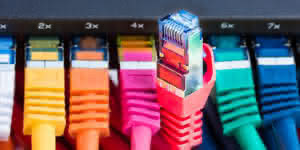For years, most Internet connections were dependent on copper cables — typically, the same lines you used to connect your home phone to the public switched telephone network.
Modern Internet technology, however, uses fiber optics to provide high-speed information transfers with a low error rate. While replacing copper with fiber optics can be expensive, the benefits of fiber often outweigh these costs.
Fiber Is Faster Than Copper
The most significant advantage of fiber over copper is its ability to transfer data quickly. Fiber optic cables, which use pulses of light to send information, can carry data at close to the speed of light.
In practice, you probably won’t run up against the transmission limits of fiber, as researchers have found that fiber optics have a theoretical transmission rate limit that could be as high as hundreds of terabits per second — 2,500 to 25,000 times faster than copper cabling.
Signals Sent Over Copper Wire Will Degrade
Copper signals also degrade over a long enough distance, meaning that if you transmit data far enough, you may begin to deal with signal degradation and loss. Most large copper networks rely on repeaters for this reason — devices that pick up signals and boost them over sections of cable.
Copper Wire Is Expensive

Not only is fiber a better choice for most applications compared to copper cabling, but it’s also typically cheaper. While copper isn’t the best option for cabling, it is an extremely versatile and valuable material — meaning you may pay a premium for copper cables or wiring compared to fiber optic cables.
The copper in the wire is still valuable even after its installation, as it can be easily recycled and reused for a wide range of purposes — often electrical wiring or motor components. As a result, copper recovered from a line replacement may be resold, in a variety of ways, potentially helping to offset the cost of the fiber installation.
Copper Is Vulnerable to Electromagnetic Interference
Another advantage of fiber optic cabling is its resistance to electromagnetic interference (EMI). Copper is vulnerable to this interference, meaning nearby electronic systems can interfere with copper’s ability to transmit signals. The cables themselves can also produce additional EMI, interfering with other wires and preventing a network from working properly — or working at all.
To protect the cables, one must invest in shielding that will block potential EMI. This shielding comes at an additional cost, and if you install copper cabling without shielding, you may find that the copper cable is unreliable or almost completely ineffective at transmitting signals.
Copper Is Less Durable Than Fiber Optics
For metalworkers and manufacturers, one advantage of copper is its ductility — it is very easy to bend and reshape as needed. This ductility makes it good for cables, which often need to bend and flex to fit around corners and into tight spaces. However, copper isn’t as tough as fiber optic cables, which means it can be vulnerable to damage during installation or remodeling.
The thin strands of glass that make up fiber optic cables are surprisingly strong. An individual glass fiber, the strands that make up the cable, may have a strength of up to 10 pounds of tension. Fiber cables are much stronger and can handle up to 800 pounds of pulling tension.
Why Fiber Optic Cables Are Becoming More Common Than Copper

If you’re installing new cables in a home or office, professionals will probably recommend using fiber optics.
These cables are typically cheaper than copper or about as expensive and provide a wide range of benefits — like faster transmission rates, EMI resistance, and a lower risk of signal degradation.
Published: December 1, 2022 • Guest Author: Devin Partida




